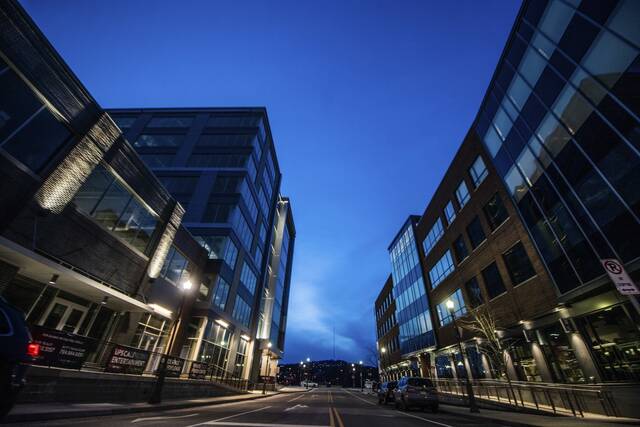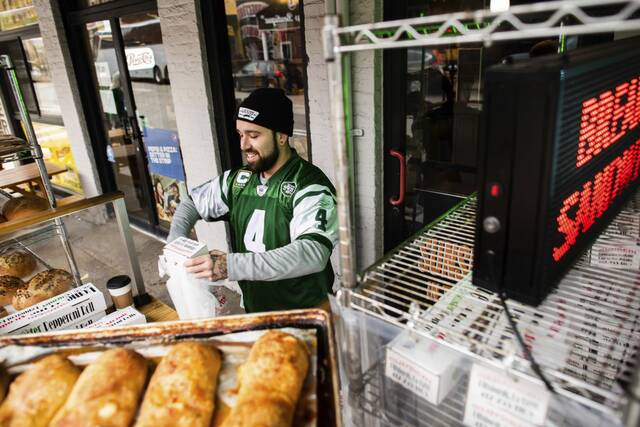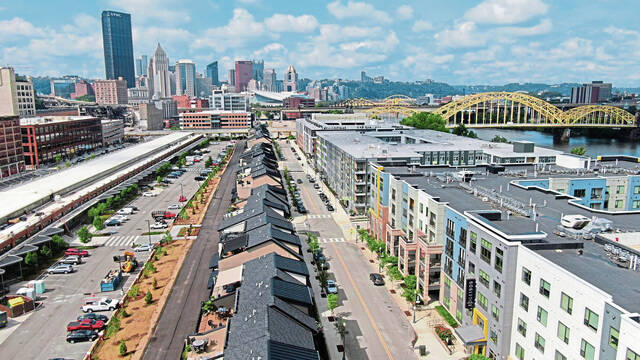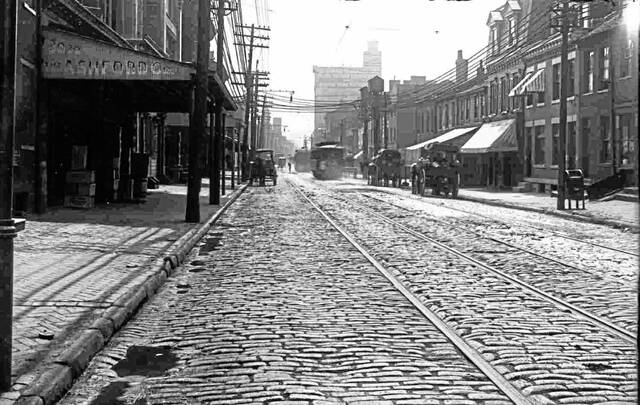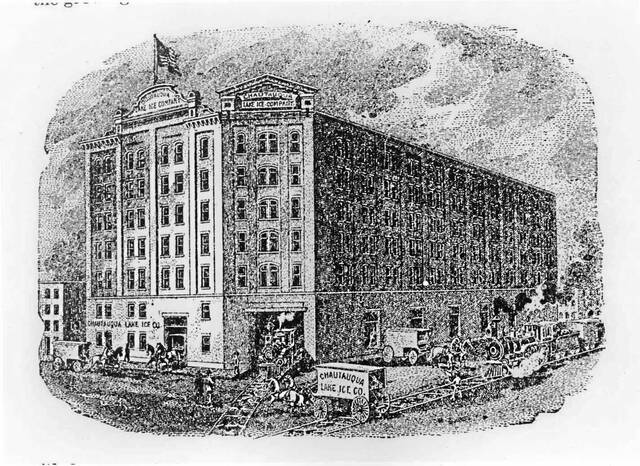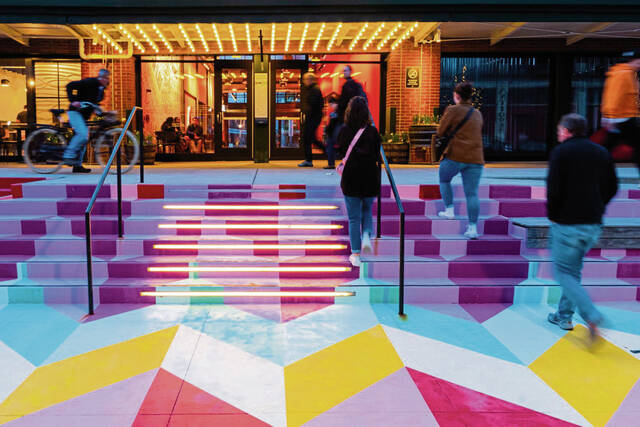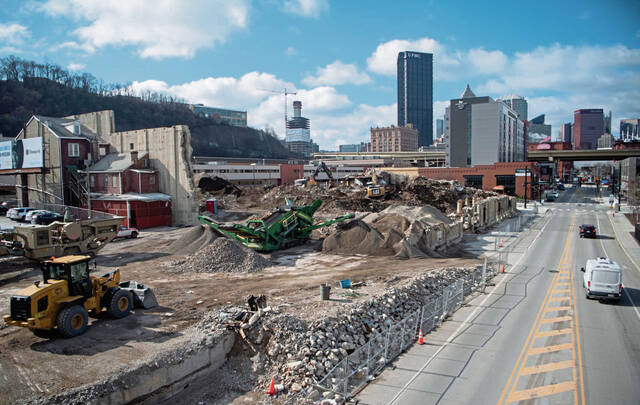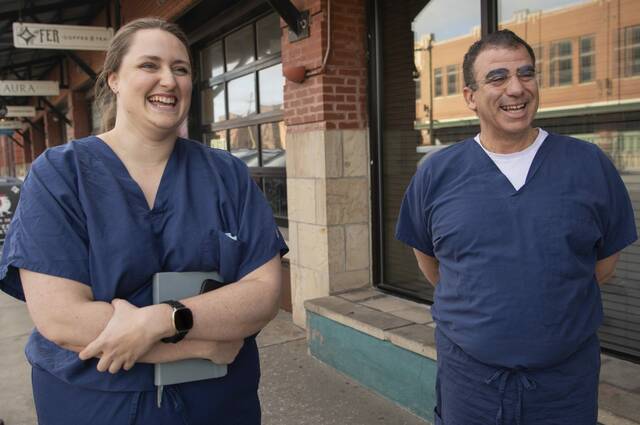Pittsburgh’s Strip District attracts 'melting pot' of new residents
Rob Brandegee picked up and moved to Pittsburgh’s Strip District to enjoy its convenience and bustling city living atmosphere.
For the growing population of Strip District residents like him, it’s not uncommon to take a walk and run into friends and acquaintances.
“It’s very sociable, and it really has a neighborhood vibe,” said Brandegee.
Brandegee relocated from Highland Park to the Strip in 2021. Part of the appeal was how easy it is to reach South Side-based Little Earth Productions, the company he co-founded that manufactures licensed apparel and accessories, like the Terrible Towel, for professional and college teams. He loves the mix of Strip District residents ranging from young professionals to middle-aged and older.
“It’s a really fun place to live,” he said. “It’s a melting pot. And it seems that people who are moving from other cities that don’t necessarily want to live in the suburbs seem to come here.”
The industrial, warehouse-dense Strip District was once more well known as one of the best spots to stroll by street vendors to buy Steelers merchandise, pick up a banh mi and bring home specialty cheese or meat at wholesale prices. At night, clubs and bars were the main attraction.
Now, the neighborhood boasts new apartments and condos in former manufacturing facilities, sending its residential population — and rents — soaring.
It’s easy for residents to stroll over within minutes to a coffee shop in the morning or to a restaurant in the evening.
On Smallman, the iconic Produce Terminal – a string of connected warehouses that opened up a portion of the docks to independent retailers, bakers and craftspeople – has been transformed into The Terminal, a bright, glossy shopping center. Vibrantly painted steps lead to businesses like Aslin Beer Company, Mayweather Boxing & Fitness and Posman’s Books, just a few blocks from long-time fixtures like Salem’s Market & Grill, Robert Wholey & Co. Fish Market and Pennsylvania Macaroni Co.
Growing population
The Strip District isn’t just a place people do business. It’s now a place that a lot more people call home.
About 2,571 people call the neighborhood home — a 233% increase in residents since 2015, and a 310% jump since 2010, according to the 2022 State of the Strip District report.
The average rent for a studio apartment was $1,438, a one-bedroom $1,890, a two-bedroom $2,674. The median sale price of a home was $831,574, the report found.
About $723.5 million worth of projects were in active construction with over $200 million more announced.
The area has about 11,245 workers and approximately 2.975 million square feet of rentable office space and another 1.26 million square feet in the pipeline, the report stated.
One project in the growing residential space is Brickworks, a proposed 300,000-square-foot development set on 3.5 acres near the historic St. Stanislaus Kostka Church.
The developer, Chicago-based McCaffery Interests, plans for the currently vacant site to include 228 luxury apartments and 60 townhomes and condos.
Brickworks has been proposed as another project of McCaffrey’s The Terminal — which redeveloped the historic produce terminal on Smallman Street — that has reached about 90% occupancy. Several food and entertainment spots within the Terminal are expected to open this spring and summer, including the music venue City Winery, Novo Asian Food Hall, and Puttshack, as well as office space for the Southwestern Pennsylvania Commission and the Richard King Mellon Foundation.
The Produce Terminal was a prominent feature of the Strip District’s thriving wholesale center dating back to the 1920s. And debates over how to preserve and redevelop the structure lasted decades. The city bought it in the 1980s and various development deals never materialized. McCaffrey began revamping the property in 2019.
“People want to live near where they work,” said Dean Welch, vice president of McCaffery. “The type of jobs that are offered in the Strip have been growing to higher-end opportunities and with that, luxury residential has followed behind.”
A tricky demolition
The demolition of the Federal Cold Storage Building — a landmark in the Strip District — took precision, down to sawing by hand through portions of the concrete walls piece by piece.
Those pieces were then lifted away by crane to a location where they could be pulverized.
In a densely populated neighborhood where the building was surrounded by neighbors, dynamite wasn’t an option to blast through the walls — thick layers of concrete sandwiching cork.
The job is nearly done — crews are still moving dirt and a few thick slabs of concrete still stand. The famous grinning neon Wholey’s fish that once adorned the side of the building is long gone. And the developer, New York-based Acram Group, is seeking an anchor tenant for a trophy office building for the site.
The project is among the most visible changes the storied neighborhood has undergone in recent years.
Andrew Masich moved to Pittsburgh 25 years ago to head up the then-new Senator John Heinz History Center.
“There really weren’t any exhibits yet in the building. It was largely an empty building with a big dirt lot,” said Masich, the history center’s president and CEO. “Across the street, I remember dust devils swirling in the wind and actual tumbleweeds blowing through the parking lot.”
Since then, millions have been invested in the neighborhood on construction projects, whether building new or rehabbing older buildings.
Still, there are challenges ahead.
For instance, the firm that is redeveloping the site for the Cold Storage Building, Acram Group, is up against a slow market for office space as companies continue to turn to remote or hybrid work schedules that don’t require as much space for employees to work.
Related:
• A guide to Pittsburgh: Strip District blends best of old and new
• Puttery Pittsburgh brings 'chic' mini golf to the Strip District
“Covid has not been incredibly helpful,” said J. Matthew Cassin, managing principal of Acram.
Still, Cassin said the pandemic has given the chance for the firm to “future-proof” the building by planning for features like hospital-grade HVAC systems and a touchless experience from when people park their car or bike to when they enter the office door.
“We’re being patient,” Cassin said. “We would like an anchor tenant to kick off the project.”
“Companies want to be able to bring people back to work and they need to bring them to environments that are compelling with great light and fresh air … healthy with modern amenities.”
The 23-floor project, a sort of transition from Downtown to the Strip, calls for a bottom floor of retail and six levels of parking then stacked with offices. The building would feature four towers, amplifying open air and green spaces for tenants. Each floor has its own outdoor deck.
‘Heart of Pittsburgh’
Mohamed Yassin likes to visit the Strip District once or twice a week. For the doctor specializing in infectious diseases at nearby UPMC Mercy in Uptown, dropping by the neighborhood is easy.
“I think it’s the heart of Pittsburgh,” the Fox Chapel resident said. “Even just walking around, it makes you feel like part of Pittsburgh. My wife and I will go to Pennsylvania Macaroni Co. to get olives and cheeses. We will stop by the bakery and get some nice bread. Then we take the car up to Mount Washington to see the view. So this place really means a lot to me.”
He said the recent development has enhanced the area.
“There were places that were deserted,” Yassin said. “Now there are new buildings, people are exercising, selling flowers and in a sense it’s an added part to the authentic part of the neighborhood.”
Yassin was walking along Smallman Street on a recent morning with Mathea Schafer, a graduate student from the University of Pittsburgh. Yassin joked that he was “advertising the place” to her. Schafer had more mixed feelings.
“I’ve lived in cities where gentrification is a big problem,” she said.
Darlene Antosz was working a stand selling T-shirts and other accessories bearing Pittsburgh pride, the type of merchandise that’s a staple along Penn Avenue.
She said that since the pandemic, and now higher prices throughout the economy, fewer people have been stopping by.
“I work seven days a week, but some days there’s nothing out here,” Antosz said. “They show up more on the weekends, but Monday through Friday is tough.”
“I think that there’s still a demand for office, but in a different way than it used to be,” Welch said. “But in a community like the Strip District, I think there are a lot of people that if they want to relocate their office or build a new office, it’s going to be top of mind, so it benefits from its location.”
Still, it could be tricky to fill office space. And commercial districts and office parks across the country are trying to reinvent themselves.
Yet more uncertainty brewed when self-driving vehicle company Argo AI announced it would close and autonomous trucking company Locomotion would reduce its headcount.
Dan Adamski, senior managing director of JLL Pittsburgh, noted that commercial construction “is almost completely halted.”
“Several large projects were delivered during the pandemic and given the work-from-home trends, hybrid work, there’s been a slowdown,” Adamski said. The projects that were completed include The Stacks and 75 Hopper Place at the 3 Crossings campus at 28th Street and Railroad Avenue, where GNC relocated its headquarters from Downtown Pittsburgh.
“The office buildings that have been built are trying to absorb the vacancies,” he said, adding that the office vacancy rate is at about 28% in the neighborhood.
Residential is showing strength, which also attracts retailers. And that helps give the neighborhood an edge over some other areas vying for attention.
Adamski said the Strip District has a “wow factor” that attracts highly sought-after talent who can live, bike and walk and visit new restaurants and brew pubs.
“That’s what companies in the post-covid world are seeking,” Adamski said. “If you have an office, it can’t be the old, beige cube farm. It’s a confluence of a bunch of attractive factors that, if you’re a company looking for a space, you look at the Strip District.”
Remove the ads from your TribLIVE reading experience but still support the journalists who create the content with TribLIVE Ad-Free.



